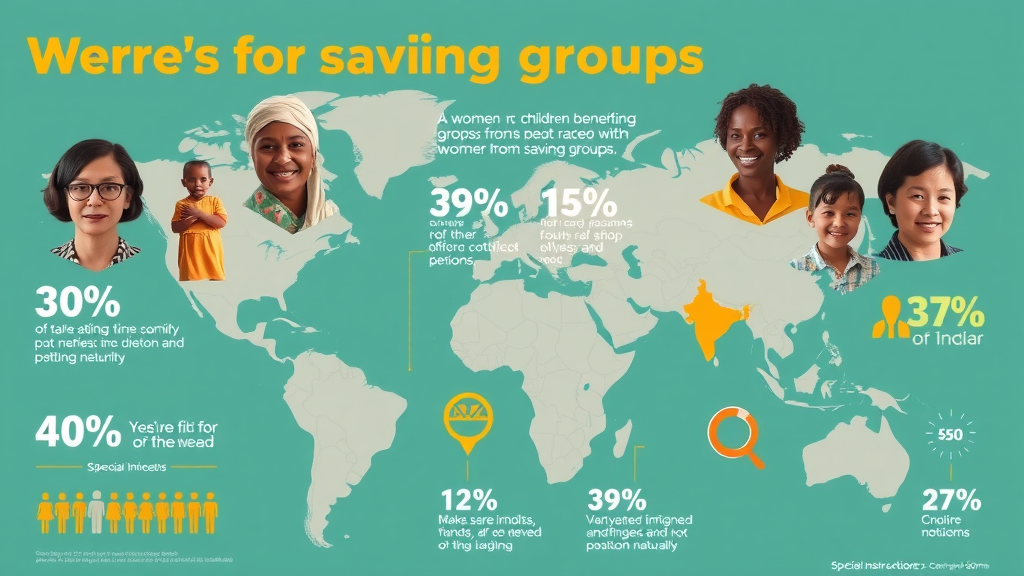How can saving groups for financial empowerment be a game changer for women and children worldwide? Startling statistics reveal that millions of women gain financial freedom and improve their children's futures through collective saving and budgeting. This article delves deep into how saving groups for financial empowerment foster economic inclusion, build trust-based capital, and create lasting change. Join Ritah Nakiganda, a passionate financial literacy advocate, as she shares her expert insights and personal experiences fueling these transformative movements.
Startling Facts About Saving Groups for Financial Empowerment
Saving groups have become a cornerstone for financial inclusion, particularly among marginalized women and children in developing regions. Globally, over 100 million people participate in saving groups, with women comprising the majority. These groups improve access to credit and provide a safe space for financial education, enabling participants to break cycles of poverty. Studies show that women involved in saving groups are 30% more likely to start and sustain small businesses, enhancing income security for their families. Additionally, children from these households exhibit improved educational outcomes and better health indicators, stemming from increased household financial stability.

Image Alt Text: Saving groups for financial empowerment global statistics and impact on women and children
What Are Saving Groups and How Do They Foster Financial Empowerment?
Understanding Village Savings and Loan Associations (VSLAs)
Saving groups for financial empowerment primarily exist as community-based financial structures known as Village Savings and Loan Associations (VSLAs). These groups consist typically of 15-30 community members who contribute savings regularly into a communal fund. Members can then borrow from this fund at reasonable interest rates, promoting self-reliance without the need for traditional banking systems. VSLAs also emphasize collective decision-making and transparency, which fosters trust and solidarity among participants. Importantly, these associations provide a platform where women and children gain access to resources otherwise inaccessible due to socioeconomic barriers.
Key Features of Effective Savings and Loan Systems
Effective saving groups share several key characteristics that enhance their function as engines for financial empowerment. First, simplicity in bookkeeping ensures all members understand transactions, reinforcing trust. Second, regular meetings promote accountability and financial education. Third, social collateral, such as mutual trust and respect, substitutes formal credit checks, making credit accessible to marginalized women and children. Fourth, adaptable rules ensure inclusion and relevance in varying contexts. Together, these features empower members to control their finances, plan for emergencies, and reinvest in their livelihoods — all essential for sustained empowerment.

Image Alt Text: Empowered women in a village savings group exchanging money for financial empowerment
The Role of Saving Groups in Promoting Financial Inclusion and Economic Empowerment
How Saving Groups Help Overcome Capital Barriers for Small Business Owners
In many communities, raising capital remains the single largest hurdle to starting or growing a business. Ritah Nakiganda, a seasoned financial literacy advocate, explains, “ Money systems give you clarity, control, and confidence with your business finances so you’re not just working hard, but working smart. ” Saving groups provide these money systems through practical savings and lending mechanisms. By accumulating collective capital, they enable women entrepreneurs to access funds without relying on risky loans or inaccessible banks. This financial autonomy breaks the cycle of survival mode to unlock entrepreneurial growth and stability.
Collective Efforts and Trust as Capital in Saving Groups
Capital in saving groups transcends mere cash contributions. Trust, commitment, and shared vision form the backbone of these collective efforts. Ritah Nakiganda’s personal story vividly illustrates this: her sister invested in her business idea based on trust rather than formal documentation. This "social capital" often proves more powerful and sustainable than traditional finance options. Saving groups thus build both financial and social wealth, propelling women and children towards economic self-sufficiency.

Image Alt Text: Diverse women holding hands showing trust and collective capital in saving groups for financial empowerment
How Saving Groups Empower Women and Children: Real-Life Impact
Building Generational Wealth Through Financial Education
Financial empowerment is incomplete without education. Saving groups often provide financial literacy training to women and children, equipping them with skills necessary to manage money effectively, budget, and plan for the future. These programs plant the seeds for generational wealth by teaching younger members how to save and invest wisely. The ripple effect of knowledge transfers from mothers to children, transforming entire families. As Ritah Nakiganda invests time coaching young women and children, she highlights the crucial role of education in breaking cycles of poverty and securing financial freedom.

Image Alt Text: Young women and children learning financial literacy in saving groups for financial empowerment
Common Questions About Saving Groups for Financial Empowerment
What is an example of a savings group?
A classic example of a saving group is a Village Savings and Loan Association (VSLA), where community members regularly save money together and lend internally. These groups are simple, low-cost, and rely on trust and transparency rather than collateral or formal approval processes.

Image Alt Text: People collaboratively managing savings group money and records for financial empowerment
What is a financial empowerment program?
A financial empowerment program is a structured initiative designed to enhance participants' ability to manage their finances, improve economic stability, and increase financial independence. These programs often include training on budgeting, saving, understanding credit, and planning for the future, all aiming to empower vulnerable groups such as women and children.
What are savings groups?
Savings groups are grassroots financial collectives where individuals pool money regularly and access loans from the accumulated funds. These groups operate on principles of trust and community support, fostering financial inclusion for those often excluded from formal banking.
What are VSLA groups?
Village Savings and Loan Associations (VSLAs) are specific types of savings groups characterized by their cyclical saving patterns, group-managed funds, and clear governance structures. They are widely adopted in rural and low-income communities as a mechanism for economic empowerment.
Key Takeaways: Why Saving Groups for Financial Empowerment Matter
- Saving groups provide accessible financial systems that build trust and collective capital.
- They empower women and children by promoting financial literacy and inclusion.
- Money systems within saving groups help small business owners manage finances smartly.
- Financial empowerment through saving groups contributes to generational wealth.
- Trust and shared belief are as important as money in capital formation.
Comparison of Different Saving Group Models: Features, Benefits, and Target Participants
| Model | Key Features | Benefits | Target Participants |
|---|---|---|---|
| Village Savings and Loan Association (VSLA) | Community-managed fund, cyclical savings, collective loans | Financial inclusion, easy access to credit, local trust | Rural women, small business owners, marginalized groups |
| Rotating Savings and Credit Association (ROSCA) | Members contribute fixed amount; fund rotates to each member | Simplicity, disciplined savings, emergency funds | Close-knit communities, families, informal groups |
| Self-Help Groups (SHGs) | Focus on savings plus social goals like education and health | Holistic empowerment, access to formal banking, social support | Women’s empowerment groups, low-income families |
Conclusion: Building Better Businesses and Financial Futures One Saving Group at a Time
Saving groups for financial empowerment are more than just financial instruments — they are lifelines transforming millions of women and children from vulnerability to prosperity. Through trust, education, and collective action, these groups dismantle traditional barriers to capital and cultivate sustainable businesses and wealth for future generations. As Ritah Nakiganda of SHEA KIDS LOUNGE Uganda poignantly puts it, “ Let’s build better businesses, one system at a time. ” Harnessing these simple yet powerful money systems creates not only financial freedom but also stronger, more resilient communities poised for lasting change.
Ritah Nakiganda of SHEA KIDS LOUNGE Uganda emphasizes, “Let’s build better businesses, one system at a time.”
People Also Ask
What is an example of a savings group?
Examples include VSLAs where community members save jointly and lend among themselves to support small businesses or emergencies.
What is a financial empowerment program?
A program that educates individuals on managing money, budgeting, and access to credit to increase economic independence.
What are savings groups?
Community-based collectives pooling savings and extending loans internally to support members financially.
What are VSLA groups?
Structured savings groups with clear governance, offering loans and savings cycles focused on rural and low-income areas.
Call to Action
Are you inspired to join or start a saving group for financial empowerment to uplift women and children in your community? Begin today by gathering trusted friends or neighbors and setting up simple money systems that provide clarity, control, and confidence. Share your story or seek guidance from experts like Ritah Nakiganda to build better businesses and brighter futures — one saving group at a time.
 Add Row
Add Row  Add
Add 




Write A Comment